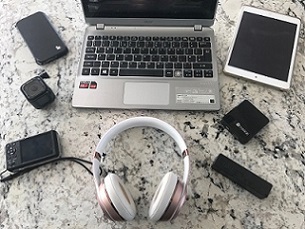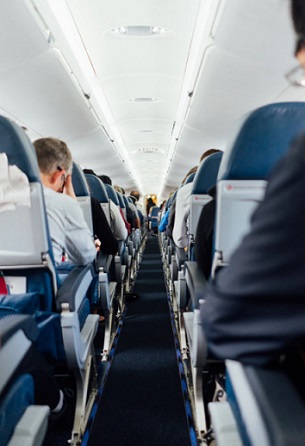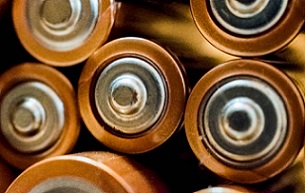 All these gadgets are regularly carried on board planes and are powered by lithium-ion batteries
All these gadgets are regularly carried on board planes and are powered by lithium-ion batteries
 An AvSax lithium battery fire containment bag
An AvSax lithium battery fire containment bag
 A fire is the last thing you want on board the confined space of a passenger aircraft
A fire is the last thing you want on board the confined space of a passenger aircraft
 PEDs and spare lithium-ion batteries should never be put in aircraft holds
PEDs and spare lithium-ion batteries should never be put in aircraft holds
We’ve all sat through the safety instructions just before taking off … but there’s a new one now which may make you wonder what’s behind it.
After warning you of the unlikely event the plane will ditch in the sea and how to inflate your life jacket, they now mention that if you lose your mobile phone then let them know immediately.
But what’s behind this warning and why is this safety message recommended by the European Union Aviation Safety Agency?
Well, in short, it’s all about the risk of a fire on board the aircraft. If your mobile has fallen down the back of the seat or into its mechanism, if you move the seat to try to search for it this could crush the phone which would badly damage the battery inside and potentially cause it to overheat and catch fire.
But mobile phones are no ordinary fires – and that’s the same for any other personal electronic devices you may lose such as iPads. For if the lithium-ion battery that powers them catches fire it can go into what’s known as thermal runaway.
This happens when one cell in a battery overheats it can produce enough heat – up to 900°C (1652°F) – to cause adjacent cells to overheat. This can cause a lithium battery fire to flare repeatedly and they are very difficult to put out which is why many airlines carry award-winning AvSax battery fire containment bags designed to deal with overheating or burning PEDs.
Mobile phones crushed after being lost down aircraft seats have sparked more than 40 fires on planes in the last 5 years and continue to be a ‘significant hazard’ in the future.
The statistics, collated by the UK’s aviation regulator the Civil Aviation Authority, were revealed in an official report into a fire on board a British Airways Dreamliner caused by a mobile phone being damaged by a seat.
The Air Accidents Investigation Branch report (AAIB) states: “The CAA has received 166 reports of PEDs lost in passenger seats in the last five years. A quarter of these events resulted in fire or smoke in the cabin, demonstrating that this is a significant hazard to the safety of the aircraft.”
Although airline manufacturers are trying to improve seat design to stop these kind of lithium-ion battery crush incidents from happening it is proving to be a challenge and there are currently no seat design requirements to prevent electronic devices from becoming trapped in seats.
The British Airways fire has highlighted this potentially dangerous issue again and has now led to a formal recommendation from the AAIB which states: “It is recommended that the Civil Aviation Authority require that passenger seats in commercial air transport aircraft are designed to minimise the chance of portable electronic devices becoming crushed in mechanisms.”
The fire on the British Airways flight happened when the Dreamliner – a plane designed to carry 296 passengers but only had 53 on board - was flying from Miami to London Heathrow on October 1, 2020. It was 40 minutes from landing when the passenger moved her seat from the bed position to an upright one before going to the toilet.
The flight crew quickly smelled a strong odour of sulphur, heard a hissing sound and then a large plume of smoke came from the seat in what they described as a ‘tornado’. The crew also saw an orange glow in the seat area among the smoke
They pulled the seat padding back and saw a mobile phone trapped in the seat mechanism and doused the phone with several bursts from a dry powder fire extinguisher as they feared using water could cause further problems as the seat’s mechanism was electrically-powered.
The red phone was hopelessly jammed in the mechanism. The pilots decided to continue the descent into Heathrow and a cabin crew member sat next to the phone with the fire extinguisher in case it flared up again. The phone was eventually removed by the fire service when the plane landed.
The investigation revealed that when the chair was adjusted by the passenger it crushed and badly damaged the phone’s battery which caused smoke, flames and fumes.
Australia’s Civil Aviation Safety Authority has previously warned: “Smartphones can fall into aircraft seat mechanisms and be crushed when the seat is moved. This can result in damage to the phone’s lithium battery which can cause overheating and fire.
“Passengers must remember never to move their seat if a phone goes missing while in-flight and to always ask the aircraft cabin crew for assistance. If a phone is damaged cabin crew should be alerted immediately.”
Personal electronic devices (PEDs) and spare lithium ion batteries should always be carried in hand luggage and not put in holds. If they catch fire in luggage they could quickly spark a bigger fire which automatic fire suppressant systems would struggle to contain.
AvSax – the world’s best-selling lithium battery fire containment bag for PEDs on aircraft - are now on more than 15,373 aircraft operated by 80 airline companies. They have been used 33 times to deal with emergencies since the start of 2017 and every time they have been deployed the aircraft has been able to complete its journey safely with no need to divert or make an emergency landing. Diversions can be very costly to the airline company and can even run into hundreds of thousands of pounds.
AvSax won the prestigious Queen’s Award for Enterprise in the UK in 2018.